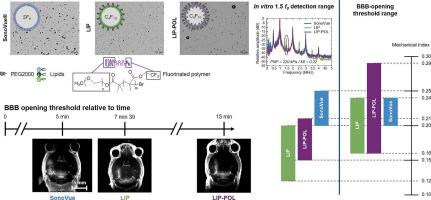Hybrid lipidic and fluorinated polymer microbubbles for blood-brain barrier opening: a comparative study with SonoVue
IF 9.7
1区 化学
Q1 ACOUSTICS
引用次数: 0
Abstract
Microbubble-mediated focused ultrasound is a promising strategy for transient and localized blood-brain barrier (BBB) permeabilization, enabling drug delivery to the brain. Optimizing microbubble stability and acoustic response is essential to maximize treatment efficiency and minimize potential damage. This study introduces an innovative microbubble formulation with a phospholipid-fluoropolymer shell (LIP-POL), designed to enhance circulation persistence while maintaining a low cavitation threshold. The physicochemical and acoustic properties of LIP-POL microbubbles were systematically compared with phospholipid-shell microbubbles (LIP) and the commercial agent SonoVue®. Both SonoVue and LIP-POL microbubbles have similar concentrations and sizes (approximately 5 × 108 bubbles/mL, mean size of 2.5-2.7 µm), whereas LIP microbubbles are around 100 times more concentrated (7.3 × 1010 bubbles/mL) and slightly smaller (1.9 µm). In vitro, ultra-harmonics appeared at 120 kPa for LIP, 150 kPa for LIP-POL, and 200 kPa for SonoVue (fc = 1 MHz, PRF = 10 kHz, 40 cycles). Consistent with microbubbles’ acoustic signature, the BBB opening threshold (fc = 1.5 MHz) occurred at lower Mechanical Indices (MI) for LIP and LIP-POL microbubbles (MI = 0.16) compared to SonoVue (MI = 0.20). Stability of circulating microbubbles was assessed using BBB permeabilization protocol at various time points post microbubble-injection. LIP-POL microbubbles remained effective for up to 15 min post-injection, compared to 7.5 min for LIP and 5 min for SonoVue (2 × 107 microbubbles injected). The prolonged efficacy of LIP-POL microbubbles (three times longer than SonoVue) opens the possibility for extended ultrasound treatments, particularly for BBB permeabilization across larger areas in large animal models or humans.

混合脂质和氟化聚合物微泡用于血脑屏障打开:与索诺维的比较研究
微泡介导的聚焦超声是一种有前途的瞬时和局部血脑屏障(BBB)渗透策略,使药物能够输送到大脑。优化微泡稳定性和声学响应对于提高处理效率和减少潜在损害至关重要。本研究介绍了一种具有磷脂-氟聚合物外壳(LIP-POL)的创新微泡配方,旨在增强循环持久性,同时保持较低的空化阈值。将LIP- pol微泡的物理化学和声学特性与磷脂壳微泡(LIP)和商用剂SonoVue®进行了系统的比较。SonoVue和LIP- pol微泡具有相似的浓度和大小(约5 × 108个气泡/mL,平均大小为2.5-2.7µm),而LIP微泡的浓度约为其100倍(7.3 × 1010个气泡/mL),并且略小(1.9µm)。在体外,LIP为120 kPa, LIP- pol为150 kPa, SonoVue为200 kPa (fc = 1 MHz, PRF = 10 kHz, 40个周期)出现超谐波。与SonoVue (MI = 0.20)相比,LIP和LIP- pol微泡(MI = 0.16)的BBB开启阈值(fc = 1.5 MHz)出现在较低的机械指数(MI)上,与微泡的声学特征一致。在微泡注入后的不同时间点,采用血脑屏障渗透方案评估循环微泡的稳定性。LIP- pol微泡注射后有效时间长达15分钟,而LIP为7.5分钟,SonoVue为5分钟(注射2 × 107微泡)。LIP-POL微泡的延长疗效(比SonoVue长三倍)为扩展超声治疗开辟了可能性,特别是在大型动物模型或人类中大面积的血脑屏障渗透。
本文章由计算机程序翻译,如有差异,请以英文原文为准。
求助全文
约1分钟内获得全文
求助全文
来源期刊

Ultrasonics Sonochemistry
化学-化学综合
CiteScore
15.80
自引率
11.90%
发文量
361
审稿时长
59 days
期刊介绍:
Ultrasonics Sonochemistry stands as a premier international journal dedicated to the publication of high-quality research articles primarily focusing on chemical reactions and reactors induced by ultrasonic waves, known as sonochemistry. Beyond chemical reactions, the journal also welcomes contributions related to cavitation-induced events and processing, including sonoluminescence, and the transformation of materials on chemical, physical, and biological levels.
Since its inception in 1994, Ultrasonics Sonochemistry has consistently maintained a top ranking in the "Acoustics" category, reflecting its esteemed reputation in the field. The journal publishes exceptional papers covering various areas of ultrasonics and sonochemistry. Its contributions are highly regarded by both academia and industry stakeholders, demonstrating its relevance and impact in advancing research and innovation.
 求助内容:
求助内容: 应助结果提醒方式:
应助结果提醒方式:


